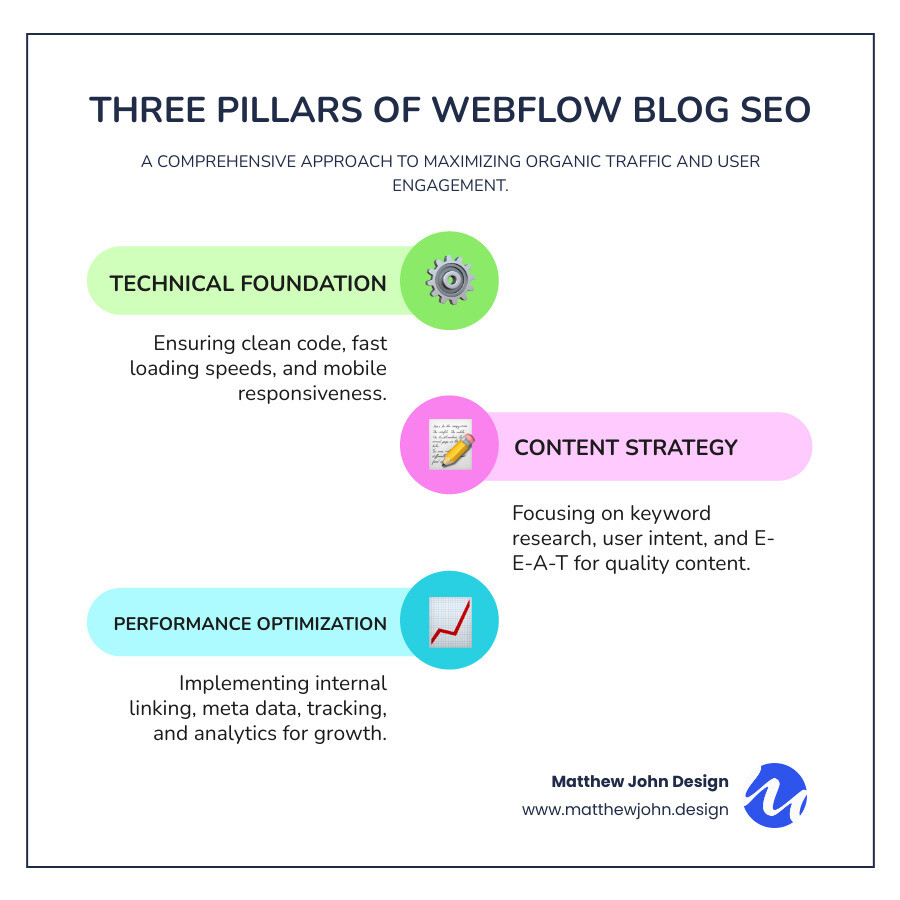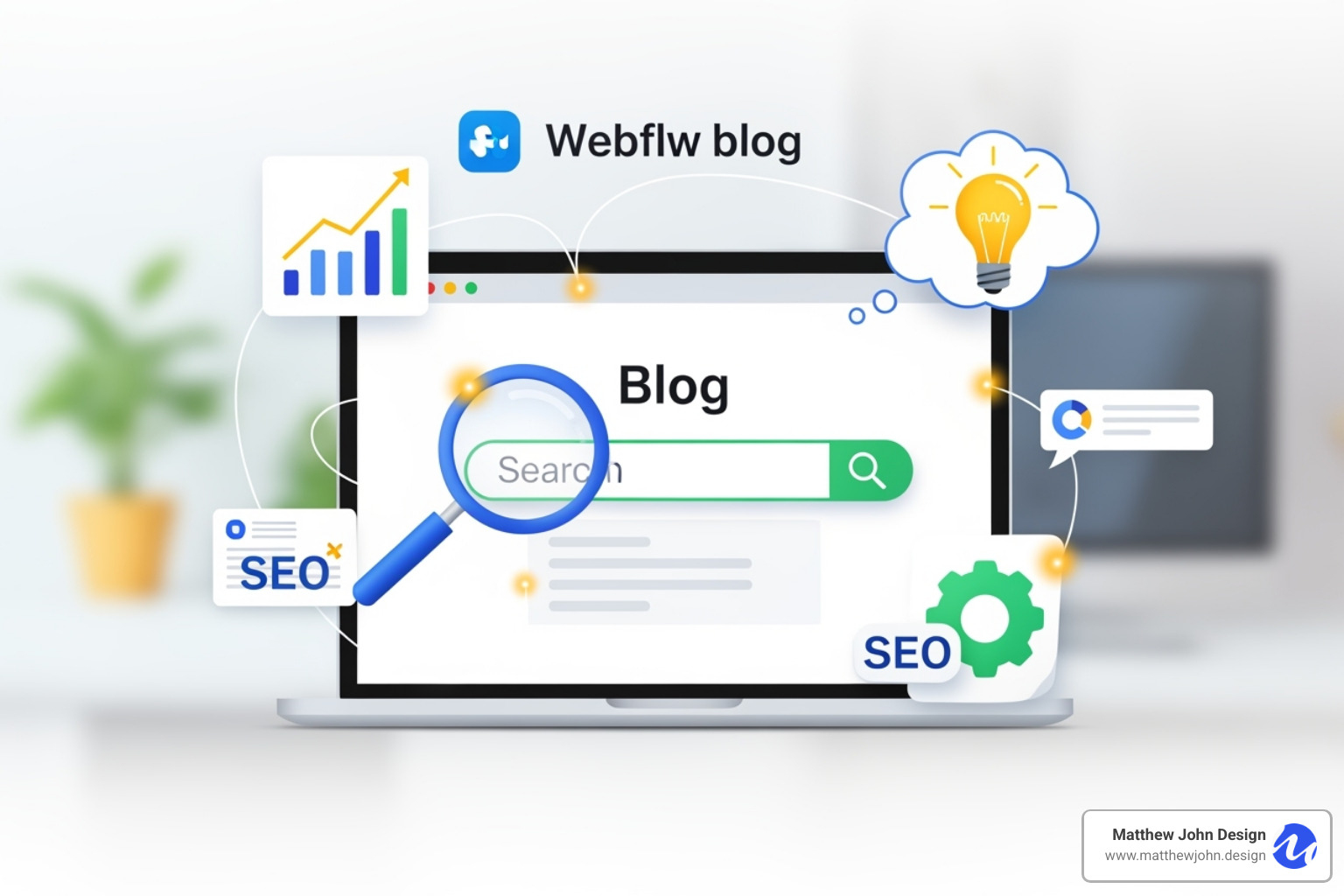Any information contained on this Website is not legal advice and should not be treated as such. You should always contact an attorney for help with your specific legal needs and issues. We may also earn a commission when you click links to our partners and purchase goods or services. For more information, read our Disclaimers Policy.
Why Webflow Blog SEO Matters for Your Growing Business
Webflow blog SEO combines the platform's clean code with strategic optimization to drive organic traffic and boost your online presence. Key elements include a strong technical foundation, optimized content, and dynamic CMS advantages for team-friendly management.
Your blog is a powerful tool for attracting qualified leads and establishing authority. With most search traffic going to the first page of Google, SEO is critical for growth.
Webflow offers a significant advantage with its clean, semantic code that search engines favor. Its visual CMS empowers marketing teams to create and optimize content without developer support. Unlike other platforms that often require plugins for core features, Webflow provides built-in SEO controls to streamline your workflow. You can customize meta titles, descriptions, and URL structures directly in the CMS, ensuring every post is optimized from the start.
Webflow solves the common challenge of balancing beautiful design with technical SEO, combining both seamlessly. This guide will show you how to leverage Webflow's capabilities to build a blog that ranks well, converts visitors, and supports your team.

The Foundation: Content Strategy for Webflow Blogs
A strong Webflow blog SEO strategy starts with your content. A great Webflow site needs high-quality content to succeed in search rankings. Google's goal is to provide users with the most helpful, relevant, and trustworthy information. Therefore, our strategy focuses on creating genuinely valuable, helpful, people-first content.
This means understanding your audience, answering their questions, and demonstrating your expertise to build topical authority. This aligns with Google's E-E-A-T guidelines: Experience, Expertise, Authoritativeness, and Trustworthiness. Share your unique insights to show readers why they should trust you.
Defining Your Audience and Search Intent
Before writing, you must understand who you're talking to. This is where keyword research and understanding search intent are crucial. It's not just about popular words, but the why behind them.
Start by creating user personas for your ideal reader. What are their challenges and goals? Tailoring content to their specific needs makes it more impactful.
Next, decode search intent—what a user wants to accomplish. The four main types are:
- Informational: Learning something ("how to automate workflows").
- Navigational: Finding a specific site ("Webflow University").
- Commercial Investigation: Researching before a purchase ("best project management software reviews").
- Transactional: Ready to act ("buy project management software").
Matching content to intent is vital. If you don't, users will leave, signaling to Google that your page isn't a good fit. Analyze SERPs (Search Engine Results Pages) for your target keywords to find content gaps—topics your competitors haven't covered well. Focus on long-tail keywords (e.g., "how to automate workflows with AI in Webflow"), which attract highly motivated users and often have better conversion rates.
Use free tools like Google Trends to see term popularity and AnswerThePublic for common questions. For scaling content, consider strategies like Programmatic SEO Webflow.
Building a Content Calendar
A content calendar is your roadmap for consistent, high-quality content. A powerful way to organize this is with topic clusters. This involves a central pillar page—a comprehensive guide on a broad topic—supported by blog posts that dig into specific subtopics. Each post links back to the pillar, signaling to search engines that you're an expert on the subject.
Your calendar should include evergreen content, which remains relevant over time, and plan for content freshness. Regularly updating older, high-performing content is key, as Google favors up-to-date information. This keeps your content accurate and signals that your site is active and valuable.
On-Page Mastery: Optimizing Your Webflow Blog Posts

With a solid content strategy, the next step is on-page SEO: optimizing individual blog posts for search engines. Webflow's intuitive interface simplifies this process. As we've noted, the answer to Is Webflow Good for SEO? is a firm yes, thanks to its clean code foundation.
Structuring Content for Readers and Robots
A well-structured post acts as a roadmap for both readers and search engine robots, improving readability and sending clear signals to Google about what's important.
Use a logical header hierarchy. Your main title must be an H1 tag (only one per page). Use H2 tags for major sections and H3 tags for subsections. Maintain a logical order (e.g., don't jump from H1 to H3).
For readability, keep paragraphs short and use bulleted and numbered lists to break up text. Use bold and italic text to highlight key points. While headings aren't a direct ranking factor, Google's John Mueller has confirmed they help Google understand a page's content, which contributes to better user experience and search performance.
Optimizing Metadata and URLs in the Webflow CMS
Your SEO titles and meta descriptions are your first impression in search results. They act as mini-advertisements to earn clicks.
SEO titles should be unique, compelling, and 50-70 characters long. Place your main keyword near the beginning. Webflow's dynamic CMS fields let you create custom "SEO Title" fields for each post.
Meta descriptions expand on the title with an enticing summary, ideally 150-155 characters. Treat them like ads, including a call to action and your focus keyword. Webflow's dynamic fields make managing these across all posts simple.
Custom URL slugs are also important. Keep them clean, descriptive, and keyword-rich (e.g., /blog/webflow-blog-seo-best-practices). Webflow gives you full control to customize these. For a walkthrough, see this video tutorial on setting up metadata in Webflow. For more tips, read our guide on Webflow Blog Optimization.
Leveraging Images and Video for SEO

Images and videos are powerful SEO assets. Since images appear in many search queries, optimizing them is crucial.
Every image needs alt text. It helps visually impaired users and gives search engines context. Google has confirmed pages can rank due to image alt text. Use descriptive alt text with relevant keywords, but avoid stuffing. Also, use descriptive image filenames (e.g., webflow-seo-dashboard.jpg).
Image compression is vital for page speed. Large files slow down your site, which hurts SEO. Compress images with tools like TinyPNG before uploading, and use modern formats like WebP for better compression without quality loss.
For video hosting, Webflow supports background videos up to 30MB but does not offer native video hosting for larger files. For anything bigger, use third-party hosting solutions like YouTube, Vimeo, or Vidzflow. You can then embed these videos into your Webflow pages to ensure fast load times. For more tips, see our guide on Webflow Video SEO.
Technical & Off-Page Power-Ups for Webflow Blog SEO
Successful Webflow blog SEO requires a solid technical foundation and strategic off-page efforts to build authority. Technical SEO is the plumbing of your site—essential for it to function correctly. Webflow handles much of the heavy lifting, but some areas need attention. For quick wins, see our Webflow SEO: 5 Tips guide.
Ensuring Peak Technical Performance for your Webflow blog seo
Technical SEO ensures search engines can find, understand, and trust your content.
- Mobile responsiveness is mandatory. With mobile-first indexing, Google primarily uses your site's mobile version for ranking. Webflow's responsive design system ensures your blog works beautifully on all devices.
- Page speed impacts user experience and rankings. Monitor performance with PageSpeed Insights. Webflow's hosting on AWS provides a solid base; further optimize by minifying HTML, CSS, and JavaScript.
- XML sitemaps, automatically generated by Webflow, act as a roadmap for Google. Submit your sitemap to Google Search Console for efficient indexing.
- The robots.txt file directs search engine crawlers away from non-essential pages, focusing them on your valuable blog content.
- Canonical tags prevent duplicate content issues by specifying the "official" version of a page.
- Schema markup (implemented via custom code) helps search engines understand content context, leading to rich snippets in search results that can improve click-through rates.
Effective Link Building and Internal Linking for Webflow blog seo
Links are digital votes of confidence. A strategic approach is key to building authority.
Internal linking is entirely within your control. By connecting related posts, you help users and search engines find more content. Use descriptive anchor text to provide context and pass authority. As Backlinko explains, this is crucial for distributing page authority.
Building quality backlinks requires creating link-worthy content—comprehensive guides or original research that others want to reference. Other strategies include guest posting on relevant sites, digital PR to share content with journalists, and broken link building, where you suggest your content as a replacement for a broken link on another site. Focus on natural, editorial backlinks, as Google penalizes manipulative schemes.
Integrating CTAs for Conversions and Engagement
Your blog posts should guide visitors toward meaningful actions. Thoughtfully placed Call-to-Action (CTAs) turn casual readers into engaged prospects.
Every post should have a purpose beyond ranking. CTAs bridge the gap between content and business goals, whether it's a newsletter signup or a service promotion. Place them naturally within your content, making them stand out without being disruptive. Well-integrated CTAs improve user experience by providing clear next steps, which can reduce bounce rates—a positive signal to Google. For more on this, read our Comprehensive Guide to CRO.
Measuring Success and Avoiding Common Pitfalls

Even the best Webflow blog SEO strategy requires monitoring. Tracking performance allows you to see what's working and make smart adjustments for continuous growth.
Tracking Your SEO Performance
Several tools help you monitor your SEO health.
Google Search Console is your direct line to Google, showing how it sees your site. You can check indexing status, search performance (queries, position, CTR), and technical issues. The URL Inspection Tool lets you see how Google views a specific page and request re-indexing after updates.
Google Analytics (GA4) provides deep insights into user behavior. Key metrics to track include:
- Organic Traffic: Visitors from search engines.
- Keyword Rankings: Your position for target terms.
- Click-Through Rate (CTR): The percentage of users who click your link in search results.
- Bounce Rate: Visitors who leave after viewing only one page.
- Time on Page: How long users stay on your content.
- Conversion Rates: The percentage of visitors who complete a desired action.
Webflow makes it easy to connect Google Analytics to get a complete picture of the customer journey.
Common Webflow SEO Mistakes to Avoid
While Webflow provides a great head start, a few common pitfalls can hinder your Webflow blog SEO efforts.
- Forgetting to disable webflow.io subdomain indexing: This can cause duplicate content issues, which can dilute your SEO authority.
- Neglecting 301 redirects: When you move or delete a page, a 301 redirect preserves link equity and prevents "page not found" errors. Webflow has tools to manage this.
- Overlooking alt text for images: Alt text is crucial for accessibility and gives search engines context about your images.
- Using multiple H1 tags on a page: This confuses search engines. Stick to one H1 per page to define the main topic.
- Not creating a custom 404 page: A generic "page not found" is a dead end. A custom 404 page can guide users back to your site.
- Missing metadata on CMS collection pages: Ensure every blog post has a unique SEO title and meta description to avoid generic snippets in search results.
- Ignoring page speed issues: Large images or too many embedded scripts can slow down your site, harming SEO and user experience.
Frequently Asked Questions about Webflow Blog SEO
Here are answers to common questions about using Webflow for your blog's SEO.
How does Webflow's CMS help with blog SEO?
Webflow's CMS is a game-changer for Webflow blog SEO. It allows you to create dynamic, structured content with custom fields for essential SEO elements like titles, meta descriptions, and alt text. This streamlines the optimization process, ensures consistency, and empowers marketing teams to manage content without developer support. It also enables programmatic SEO, allowing you to scale content production efficiently.
Is Webflow better than other platforms for blog SEO?
Webflow is a very strong contender for blog SEO. It provides a clean code foundation that search engines love, excellent page speed, and granular control over on-page and technical SEO. Unlike some platforms that rely on third-party plugins for core SEO features, Webflow has many capabilities built-in. This combination of design flexibility, native SEO controls, and clean code offers a powerful advantage for creating high-performing blogs.
What are the most important metrics to track for blog SEO success?
To measure your Webflow blog SEO success, track these key metrics in Google Analytics and Search Console:
- Organic Traffic: The number of visitors from search engines.
- Keyword Rankings: Your position in search results for target keywords.
- Click-Through Rate (CTR): The percentage of people who see and click your search result.
- User Engagement: Signals like bounce rate and average time on page, which indicate content quality to Google.
Conclusion: Turn Your Webflow Blog into a Growth Engine
Optimizing your Webflow blog SEO is about building an authoritative content hub that serves your audience and drives business growth. By defining your audience, crafting helpful content, mastering on-page elements, ensuring technical soundness, and measuring your efforts, you can create a powerful asset.
Webflow provides an excellent foundation for SEO success with its clean code, robust CMS, and built-in optimization tools. This powerful combination of design and performance allows your marketing team to focus on connecting with customers, not on technical problems.
At Matthew John Design, we specialize in building Webflow sites with scalable, component-based systems that internal marketing teams can easily manage. We don't just build websites; we build growth engines. Ready to lift your content strategy and build a blog that ranks? Explore our SEO & Content Services and let's make your Webflow blog a true asset!

